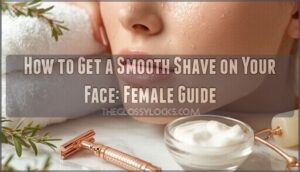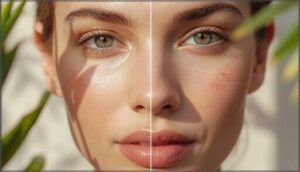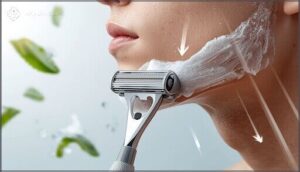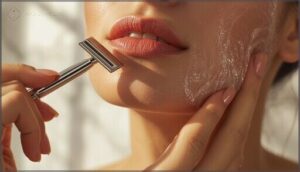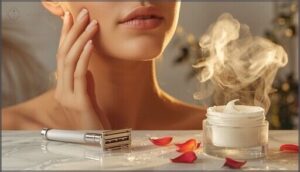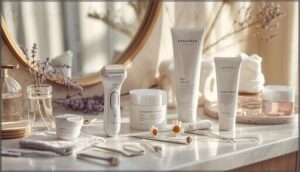This site is supported by our readers. We may earn a commission, at no cost to you, if you purchase through links.
Facial shaving isn’t a beauty trend—it’s a technique dermatologists have recommended for decades to improve skin texture and remove fine hair. Women naturally have two types of facial hair: fine, translucent vellus hair and coarser terminal strands that appear on the upper lip, chin, and jawline.
When you shave your face correctly, you remove dead skin cells along with unwanted hair, creating a smoother surface for makeup and skincare products.
The key to achieving a smooth shave on your face as a female lies in proper preparation, the right tools, and gentle technique. Without these fundamentals, you risk irritation, ingrown hairs, and uneven results that make the process more frustrating than beneficial.
Table Of Contents
Key Takeaways
- Facial shaving removes dead skin cells and fine hair simultaneously, improving skin texture by roughly 34% and boosting product absorption up to 2.3 times when done correctly with proper preparation and technique.
- Shaving with the grain using light, short strokes on taut skin minimizes irritation by up to 40%, while common mistakes like dry shaving or dull blades spike irritation by 73% and double nick risk.
- Post-shave care with alcohol-free moisturizers containing hyaluronic acid or glycerin and broad-spectrum SPF 30+ sunscreen is essential, as shaving temporarily thins your skin’s protective barrier and increases UV vulnerability.
- Women with excessive facial hair growth should consider underlying medical conditions like PCOS (affecting 70-80% of women with hirsutism), which may require hormone therapies rather than just hair removal methods.
Types of Facial Hair in Women
Your face has two distinct types of hair, and knowing the difference helps you choose the right removal method. Genetics and hormones play a major role in determining where hair grows and how thick it appears.
Several factors influence whether facial hair is barely noticeable or something you want to address.
Vellus Vs. Terminal Hair
Your face carries two distinct hair types, each with its own story. Vellus hair—often called peach fuzz—is that fine, translucent layer covering much of your skin. It’s short, thin, and barely visible. Terminal hair, on the other hand, is darker and thicker, appearing on your upper lip, chin, and jawline.
Key differences in hair structure:
- Vellus hair lacks the central medulla found in terminal hair and remains mostly translucent
- Terminal hair grows longer and coarser, with pigmented shafts reaching up to three feet on the body
- Clinical assessment uses digital analysis to measure density, with forehead vellus hair averaging 439 hairs per square centimeter
Terminal hair grows about 1 centimeter monthly—much faster than vellus hair’s 0.03 millimeters daily. These hairs both aid in the thermoregulation process. Understanding these differences helps you choose the right facial shaving approach for your skin and hair visibility needs.
Genetic and Hormonal Influences
Family history shapes up to 60% of facial hair patterns. If your mom or sisters have noticeable facial hair, you’re likely to see similar growth.
Hormonal influences on hair growth stem from androgen levels—elevated testosterone triggers follicles to produce thicker, darker strands. Receptor sensitivity varies genetically, explaining why some women develop hirsutism with only mild hormonal imbalances.
Elevated testosterone triggers thicker facial hair, while genetic receptor sensitivity explains why some women develop hirsutism with minimal hormonal shifts
Medical conditions like PCOS affect 70-80% of women with excess facial hair. Complete hormone testing can help diagnose the underlying causes of hirsutism and assess androgen levels.
Factors Affecting Hair Thickness and Visibility
Beyond genetic and hormonal influence, several factors determine how visible your facial hair appears:
- Ethnic Variations: Women of South Asian and Middle Eastern descent often show hair density up to threefold higher than East Asian women, even at identical hormone levels.
- Skin Contrast: Dark hair on fair skin creates chromatic contrast that amplifies visibility—the same hair pigmentation appears less noticeable on darker complexions.
- Menopause Changes: Declining estrogen after age 45 shifts your follicle sensitivity, converting fine vellus hairs to coarser terminal strands along your chin and jawline.
- Iatrogenic Factors: Certain medications and repeated plucking can trigger inflammation that thickens regrowth, altering your natural hair growth cycle.
Benefits and Drawbacks of Facial Shaving
Facial shaving can transform your skin’s texture and appearance, but it’s not without potential downsides. Understanding both the advantages and risks helps you make an informed decision about whether this method fits your skincare routine.
Let’s look at what you gain—and what you need to watch out for.
Exfoliation and Skin Brightening
Shaving exfoliation removes about 18–22 microns of stratum corneum—roughly five days’ worth of dead skin cells—revealing a smoother surface beneath. This process not only enhances skin texture but also boosts brightness by approximately 29% through better light reflection. Additionally, product penetration is significantly improved, with serums absorbing nearly 2.3 times more effectively after exfoliation. However, it’s crucial to consider the barrier impact; dry shaving increases water loss, making proper moisturizing essential.
| Exfoliation Effect | Measured Benefit |
|---|---|
| Dead skin cells removed | 18–22 microns |
| Surface roughness reduction | ~34% decrease |
| Brightness increase | ~29% improvement |
| Product absorption boost | ~2.3× penetration depth |
| Hydrating serum efficacy | ~78% on treated skin |
Enhanced Makeup Application
When you remove vellus hair and dead cells, foundation blending improves dramatically—your base glides on with an airbrushed finish instead of clinging to peach fuzz. Powder adherence increases, coverage enhancement becomes visible, and product longevity extends through humid conditions.
Smoother skin from proper skin preparation and exfoliation creates an even canvas, making your makeup application techniques more effective and your overall look more polished.
Risks: Ingrown Hairs and Irritation
Although shaving brightens skin, it carries real risks—especially if you have curly hair or skin sensitivity. Ingrown hairs develop when short, sharp strands curl back into the epidermis, triggering redness and inflammatory bumps.
High shaving frequency, product allergies, and poor shaving practices compound irritation, leading to razor burn and barrier disruption that can persist for weeks without adjustment.
Preparing Skin for a Smooth Shave
Preparation is the foundation of a smooth, irritation-free shave. The right steps before you pick up a razor can mean the difference between soft, glowing skin and redness or ingrown hairs.
Here’s what you need to do to set your skin up for success.
Cleansing and Softening Hair
Think of cleansing as laying the groundwork for your smoothest shave yet. Washing your face with warm water removes dirt and softens hair, reducing irritation by up to 40%. Follow this preferred sequence:
- Remove makeup using a gentle facial cleanser
- Apply enzymatic exfoliation to lift dead skin cells
- Soak with warm water for 3–5 minutes
- Layer pre-shave oil before shaving cream or gel for enhanced glide
Choosing The Right Razor
Your razor choice influences both comfort and results more than most people realize. Manual razors with multiple blades and moisturizing strips reduce razor burn, while electric models suit sensitive skin. Here’s what matters most:
| Razor Feature | Why It Matters |
|---|---|
| Blade Material | Stainless steel stays sharper longer |
| Handle Ergonomics | Better grip prevents slips and nicks |
| Blade Count | Multiple razor blades offer closer shaves |
| Brand Comparison | Braun leads with 35% U.S. market share |
Cartridge razors dominate with a 37.73% market share, thanks to their upgraded features.
Selecting Shaving Cream or Oil
Your pre-shave product can make or break your results. Shaving cream provides cushioning and lift for coarser hair, while transparent oils offer better visibility for precise work around contours.
Look for fragrance-free formulas—fragrance allergies affect up to 4.2% of people. If you’re acne-prone, choose non-comedogenic options like water-based gels or lightweight oils with sunflower seed or grapeseed bases.
Step-by-Step Facial Shaving Techniques
Once your skin is prepped, the shaving technique you use makes all the difference between smooth results and irritation. The right approach minimizes nicks, razor burn, and ingrown hairs while maximizing comfort.
Here’s how to shave your face safely and effectively.
Shaving With The Grain
Ever wondered why some shaves leave your skin calm while others leave it angry? Shaving with the grain—following your natural hair growth—offers irritation reduction and real ingrown prevention.
Start with hair growth mapping so your blade moves in sync. This technique delivers a smooth result, improves shave closeness, and follows practical guidelines for sensitive skin, especially when paired with proper skin preparation.
Pulling Skin Taut in Tricky Areas
Following hair growth direction sets you up for success, but facial shaving techniques matter even more when you reach curved spots.
Pulling skin taut in tricky areas—like your jawline, upper lip, and chin contours—creates a smooth, flat surface for your blade. Stretch delicate zones gently to reduce nicks, control your tool angle at roughly 45 degrees, and avoid dragging over uneven skin.
Shaving techniques that prioritize tension deliver safer, cleaner results.
Using Light, Short Strokes
Taut skin sets you up, but stroke technique makes or breaks your shave. Light, short movements—one to two centimeters each—reduce drag and let your blade graze rather than press into sensitive zones. Here’s how to nail gentle, smooth facial shaving techniques:
- Keep strokes brief and controlled for better pressure management.
- Hold your razor at a 45-degree blade angle.
- Rinse frequently to prevent razor clogging.
- Minimize stroke overlap to protect delicate skin.
- Let the blade’s weight do the work on your women’s face contours.
Short passes lower irritation and give you precision around curves.
Avoiding Common Shaving Mistakes
Even perfect strokes won’t save you from dry shaving or dull razors—two errors that spike irritation by 73% and double your nick risk.
Skip shaving over irritated skin, ease up on excessive pressure, and never neglect post-shave care. These common shaving mistakes undermine every technique you’ve mastered. When shaving techniques matter this much, small fixes deliver a closer shave and genuinely smooth results.
Post-Shave Skin Care Essentials
After you shave, your skin needs immediate care to stay calm and protected. The right steps can prevent irritation and keep your complexion smooth and healthy.
Focus on two key actions: moisturizing to restore your skin’s barrier and applying sunscreen to guard against UV damage.
Moisturizing and Soothing Skin
After rinsing with cool water, you’ll want to lock in moisture with an alcohol-free moisturizer. Look for hydration ingredients like hyaluronic acid, glycerin, or chamomile extract—these soothing moisturizers help with irritation reduction and support your skin’s barrier.
Post-shave balms with aloe or shea butter deliver long-term benefits, keeping your face soft and calm while ensuring ingredient safety for repeated use.
Applying Sunscreen for Protection
After you moisturize, applying sunscreen becomes your final shield. Shaving thins the stratum corneum temporarily, making your skin more vulnerable to UV damage.
Use a broad-spectrum SPF 30 or higher—mineral formulas with zinc oxide irritate less on freshly shaved skin. Apply about a quarter teaspoon to your face and neck, and reapply every two hours outdoors to maintain protection.
Alternatives to Shaving and Special Considerations
Shaving isn’t your only option for managing facial hair. Other methods offer different benefits, from longer-lasting results to targeted solutions for stubborn growth.
Let’s look at some alternatives and what to think about if hormones or medical conditions are affecting your hair growth.
Waxing, Threading, and Dermaplaning
If shaving doesn’t suit your skin sensitivity, waxing, threading, and dermaplaning are alternative hair removal methods worth considering. Each offers different benefits regarding pain level, hair regrowth timing, and long-term effects—though cost comparison and skin reactions vary greatly.
- Waxing keeps skin smooth for 2 to 6 weeks but causes temporary redness and dryness
- Threading provides precise hair removal for 2 to 4 weeks with minimal exfoliation
- Dermaplaning removes dead skin cells while eliminating fine hair, lasting 3 to 4 weeks
- Professional waxing and its effects range from €30–€70 per session
- Threading and dermaplaning both require monthly maintenance for sustained results
Laser and Chemical Hair Removal
Laser hair removal offers 52–85% facial hair reduction after several sessions, with 810 nm diode lasers averaging 74–79% efficacy at three to six months. You’ll need four to eight treatments costing $150–$400 each—totaling $800–$2,400 for full-face results.
Chemical depilatories break down hair at the surface but risk burns if you exceed recommended times, so always patch-test before applying these alternative hair removal methods.
Managing Hair Growth From Medical Conditions
If you experience rapid facial hair growth, conditions like PCOS, CAH, or Cushing’s syndrome may be driving elevated androgens—about 70% of women with PCOS report prominent facial hair.
Medical conditions causing hair growth require hormone therapies such as spironolactone or oral contraceptives, which can reduce terminal hair by measurable amounts within two to six months, improving PCOS management and addressing menopause effects.
Frequently Asked Questions (FAQs)
How often should women shave their face?
Most women shave their faces one to two times per week, with frequency depending on hair growth rate, skin sensitivity levels, and personal preference.
Daily shaving is less common but manageable with proper technique.
Can facial shaving cause hair to grow thicker?
No, it won’t. Scientific study findings from decades of research confirm shaving doesn’t change hair follicle impact or structure.
Perceived thickness change comes from blunt tips—not actual hair regrowth myths or hormonal influence hair.
Whats the best time to shave your face?
Shaving in the evening offers clear advantages. Your skin’s circadian rhythm aids overnight recovery, and post-shower hydration softens hair for smoother strokes. You’ll also avoid daytime UV exposure on freshly shaved skin.
Should you shave before or after showering?
Ironically, rushing to shave before your morning shower sabotages results. Warm water hydrates skin and softens hair, reducing razor drag and irritation.
Shaving after showering—with proper preparation and shaving cream—delivers smoother, safer outcomes.
Does facial shaving work for all skin types?
Not entirely. While 64% of surveyed individuals tolerate facial shaving well, skin type considerations matter greatly. Sensitive skin or active conditions like eczema, psoriasis, or acne increase irritation risk. A dermatologist can assess shaving suitability and recommend alternatives.
Conclusion
Your skin deserves the same careful attention you’d give any medical procedure—because that’s exactly what shaving is. A smooth shave on your face as a female requires preparation, precision, and post-care, not guesswork.
When you follow these evidence-based steps, you’ll lessen irritation and improve results. The difference between frustration and success lies in technique, not luck.
Take control of your skincare routine with methods that work, and you’ll see the difference immediately.
- https://www.grandviewresearch.com/industry-analysis/dermaplaning-tools-market-report
- https://www.globenewswire.com/news-release/2024/09/04/2940964/0/en/Global-Dermaplaning-Tools-Market-Size-To-Worth-USD-1216-9-Million-By-2033-CAGR-Of-7-28.html
- https://pmc.ncbi.nlm.nih.gov/articles/PMC6735171/
- https://www.westdermatology.com/2022/11/08/womens-face-shaving-what-you-need-to-know/
- https://www.vogue.in/content/is-a-face-razor-safe-vogue-asks-dermatologists-to-settle-the-debate

